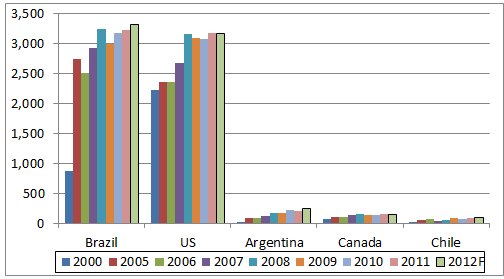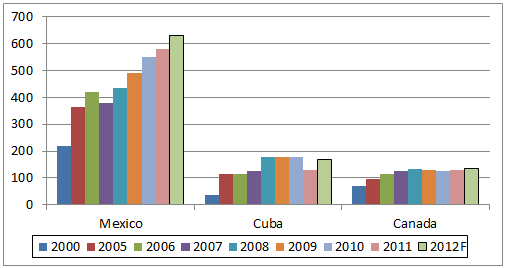



GLOBAL POULTRY TRENDS 2012 - Americas Account for 70 Per Cent of World Chicken Exports
The Americas is the most important region of the world for exports of fresh/chilled/frozen chicken meat, accounting for some 67 per cent of the global total in 2009, according to Terry Evans in his latest analysis of the world's poultry industry.Global trade in fresh, chilled and frozen chicken meat increased by almost four million tonnes at five per cent a year between 2000 and 2009 to reach some 10.7 million tonnes. However, when allowance is made for sales of prepared/processed chicken, which increased dramatically as a result of countries banning imports following outbreaks of highly pathogenic avian influenza (HPAI) in the exporting country, then it looks as though total chicken meat exports increased by some five million tonnes from around 7.7 million tonnes to more than 13 million tonnes. Note that these figures do not include the trade in chicken paws. Since then, although the business has continued to grow, the rate has declined to an estimated three per cent a year, while one forecast to 2021 points to trade expanding at little more than two per cent a year.
The Americas is the most important region regarding exports of fresh/chilled/frozen chicken meat accounting for some 67 per cent of the global total of 10.7 million tonnes in 2009 (table 1). For this region, exports increased faster than the world total, achieving an annual growth rate of almost eight per cent as total shipments went up by 3.6 million tonnes to 7.2 million tonnes.
In 2009, the US was the leading exporter of chicken meat followed by Brazil, these two accounting for 6.8 million tonnes or nearly 94 per cent of the regional total (table 1). However, data presented by the USDA relating to what are considered to be broiler exports (table 2) reveals that since 2009, the ranking of the top two countries has been reversed, with Brazil moving into the number one spot, a position which it is expected to hold this year with shipments of around 3.3 tonnes compared with almost 3.2 million tonnes for the US. Furthermore, one long-term forecast to 2021 shows no change in the relative positions of these two countries.
With almost 20 per cent of US chicken production being exported, robust and expanding international markets are essential to the fortunes of the US broiler industry. Since 2008, annual US broiler exports have shown only small movement around an average of 3.2 million tonnes (table 2), while the forecasts to 2021 point to only a slight increase to around 3.4 million tonnes.
Exports reached a record 3.17 million tonnes in 2011. Although shipments to several markets – Russia, the Ukraine and Cuba – showed a significant contraction, increased trade with Hong Kong, Korea, Iraq, Mexico, Angola and Canada helped to push the total to the record level. Purchases by Mexico rose by four per cent to almost 458,000 tonnes, while Hong Kong’s receipts went up by 20 per cent to 235,000 tonnes. Exports to Korea jumped by 54 per cent to 109,000 tonnes while Canada took 12 per cent more at 142,000 tonnes. Increased trade was also recorded with the United Arab Emirates, Oman, China, the Philippines, Haiti, Japan, Singapore, Jordan, Chile, Gabon and Kazakhstan.
The first quarter of 2012 witnessed an increase of 14 per cent in US broiler exports to almost 790,000 tonnes. Mexico was the top market, taking 11 per cent more year-on-year at 128,000 tonnes and, a little surprisingly, shipments to Russia almost doubled to 53,000 tonnes, purchases by Cuba rose four-fold to 45,000 tonnes, while Taiwan’s receipts rose nine per cent to 41,000 tonnes.
Latest estimates indicated that the annual total this year will show a small increase over 2011 at 3.19 million tonnes. However, a slight reduction is envisaged for 2013 to 3.16 million tonnes as trade disputes, tariffs, quotas and non-tariff barriers continue to restrict US chicken exports.
Exports of US leg quarters have fallen from 1.9 million tonnes in 2008 to 1.6 million tonnes last year, primarily because Russia’s purchases declined from 755,000 tonnes to just 169,000 tonnes. Over the same period, shipments to Mexico went up from 92,000 tonnes to 153,000 tonnes, leading to a trade dispute between the two countries, which is not expected to be fully resolved until later this year. The US and China have involved the World Trade Organization (WTO) to try and resolve a dispute whereby China has imposed high duties on US chicken paws considering that they were being ‘dumped’. Three US free-trade agreements with South Korea, Colombia and Panama, signed in October 2011 are expected to generate an estimated $1.4 billion annually in additional poultry and egg export sales.
Brazil is the world’’s leading broiler exporter and is expected to hold this position for the foreseeable future. Indeed, one forecast to 2021 for the combined exports for both broiler and turkey meat, indicates that the gap between Brazil and US shipments will widen, with the projection for Brazil exceeding 4.8 million tonnes being more than one million tonnes above the comparable figure for the US. If chicken paws are included, Brazil’s total chicken meat exports in 2011 amounted to about 3.8 million tonnes. However, in Table 2, in keeping with all the other trade figures, sales of feet/paws have not been included. Leading buyers of Brazilian chicken are Saudi Arabia, Japan, United Arab Emirates, Hong Kong/China, South Africa and the European Union, these accounting for 62 per cent of the business. The markets showing the most rapid expansion in 2011 were China, Angola and Iraq, while a major decline of 58 per cent was recorded in sales to Russia as a result of a significant number of Brazilian plants being delisted by the Russian authorities.
Brazil’s chicken meat exports in the first quarter of 2012 at 974,000 tonnes were almost 4.5 per cent above the year-earlier level. Shipments of cuts expanded by almost 13 per cent to 543,000 tonnes while sales of salted meat rose by six per cent to 41,500 tonnes. Exports of whole birds fell by 6.5 per cent. The Middle East was the largest market taking 316,000 tonnes – down 12.7 per cent primarily through lower sales to Iran – while Asian countries took 294,000 tonnes (up 16.8 per cent). However, exports to Africa jumped by almost 41 per cent to 159,000 tonnes. According to Francisco Turra, president of the Brazilian Poultry Union (UBABEF), the industry is increasingly directing its export business towards higher priced value-added products.
Current concerns facing Brazilian exporters, according to a USDA GAIN report, include: an overvalued Brazilian currency; uncertainties resulting from the global financial crisis, especially in Europe; specific issues with major trading partners such as the Russian Federation’s delisting of Brazilian plants and South Africa’s anti-dumping tariffs on whole birds and parts. Nevertheless, for 2011 and 2012, it looks as though Brazil has been able to maintain its global market share of broiler meat exports at around 34 per cent. However, the re-opening of the Japanese and EU markets to Thai raw chicken will make life more difficult for Brazilian exporters. Despite a bi-lateral trade agreement with China, not all Brazilian plants have been granted permission to export to China as they have yet to implement the technical and hygienic procedures required.
Although small when compared with Brazil and the US, exports of chicken meat by Argentina of some 250,000 tonnes to some 70 countries, represent some 18 per cent of national production and the aim is to increase this percentage to 25 per cent by 2017. Leading destinations include Venezuela, Chile, South Africa and China.
Since 2000, the chicken industry in Chile has grown by three per cent a year to around 500,000 tonnes in 2010. In recent years, this country has become more active in the export market with sales this year forecast to reach 100,000 tonnes.

Whereas the Americas accounts for some 67 per cent of global exports of fresh/frozen chicken meat, on the import side of the trade balance sheet, this region accounts for only some 11 per cent of the business. Back in 2009, the Americas imported almost 1.2 million tonnes, of which more than 480,000 tonnes (41 per cent) was purchased by Mexico, while Cuba took 160,000 tonnes and Canada 141,000 tonnes, these three accounting for two-thirds of the total.
Currently, Mexico imports some 630,000 tonnes a year (Table 4), of which about 90 per cent comes from the US, with Chile the only other significant supplier. A long-term forecast suggests that Mexico’s imports of both broilers and turkeys could exceed one million tonnes by 2021.
Chicken production in Cuba has declined dramatically from a peak of around 90,000 tonnes a year back in 1983 to around 30,000 tonnes nowadays. Chicken consumption has almost doubled since 2000 and consequently the demand gap has been filled by imports, mainly from the US, which have escalated from 38,000 tonnes back in 2000 to an estimated 170,000 tonnes for this year.
Under the supply-management system in pace in Canada, broiler imports are curtailed and subject to a tariff rate quota which is a function of the level of production. In recent years, the quantities imported have been relatively steady at around 130,000 tonnes a year with some 85 per cent coming from the US and 12 per cent from Brazil.

August 2012












